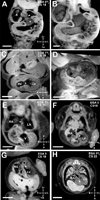Human cardiac development in the first trimester: a high-resolution magnetic resonance imaging and episcopic fluorescence image capture atlas
- PMID: 19635979
- PMCID: PMC3411176
- DOI: 10.1161/CIRCULATIONAHA.108.796698
Human cardiac development in the first trimester: a high-resolution magnetic resonance imaging and episcopic fluorescence image capture atlas
Figures








References
-
- Kramer T. The partitioning of the truncus and conus and the formation of the membranous portion of the interventricular septum in the human heart. Am J Anat. 1942;71:343–370.
-
- Grant RP. The embryology of ventricular flow pathways in man. Circulation. 1962;25:756–779. - PubMed
-
- Goor DA, Edwards JE, Lillehei CW. The development of the interventricular septum of the human heart; correlative morphogenetic study. Chest. 1970;58:453–467. - PubMed
Publication types
MeSH terms
Grants and funding
LinkOut - more resources
Full Text Sources
Medical

